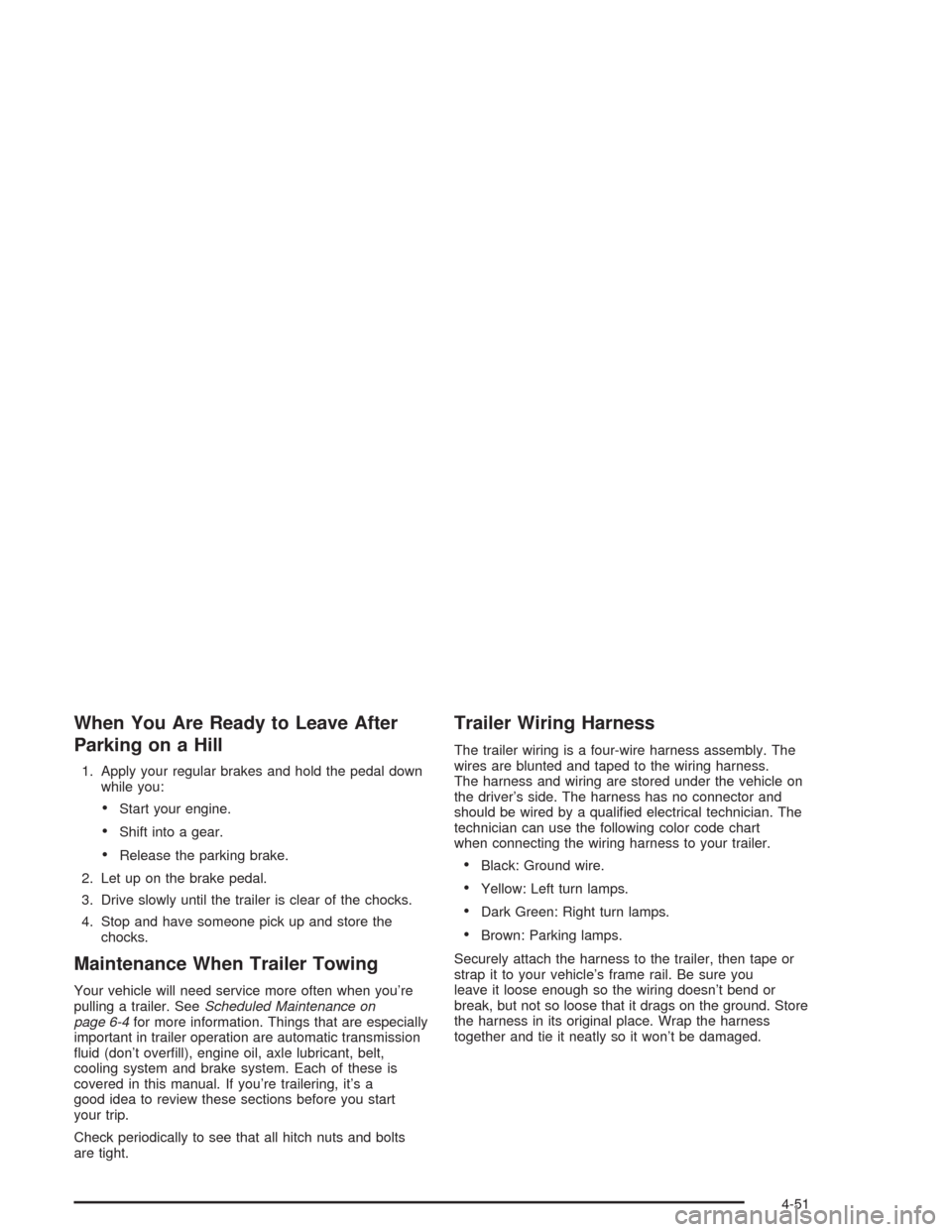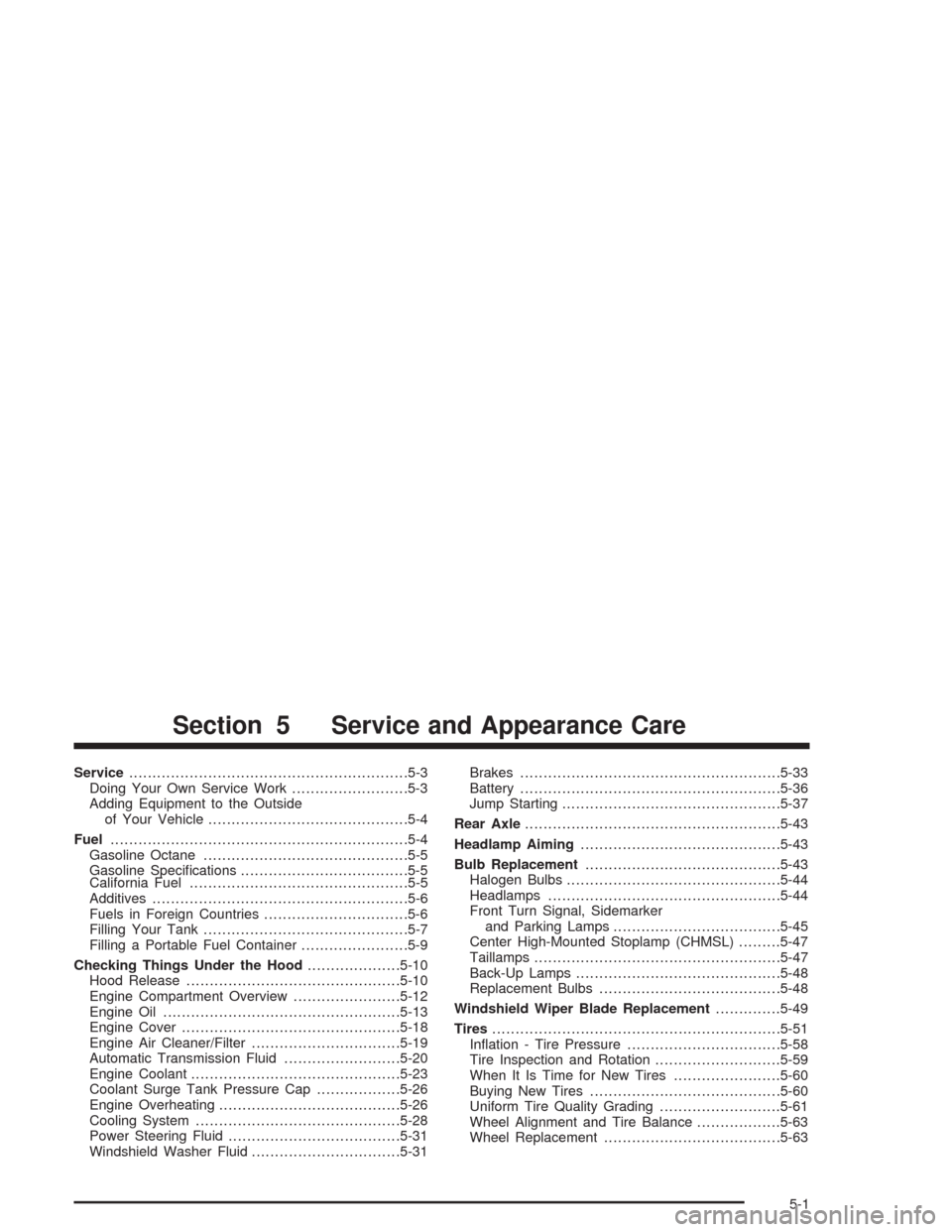stop start CHEVROLET SSR 2004 1.G Owner's Manual
[x] Cancel search | Manufacturer: CHEVROLET, Model Year: 2004, Model line: SSR, Model: CHEVROLET SSR 2004 1.GPages: 398, PDF Size: 2.49 MB
Page 222 of 398

The heavier the rain, the harder it is to see. Even if your
windshield wiper blades are in good shape, a heavy
rain can make it harder to see road signs and
traffic signals, pavement markings, the edge of the road
and even people walking.
It is wise to keep your wiping equipment in good shape
and keep your windshield washer tank �lled with
washer �uid. Replace your windshield wiper inserts
when they show signs of streaking or missing areas on
the windshield, or when strips of rubber start to
separate from the inserts.Driving too fast through large water puddles or even
going through some car washes can cause problems,
too. The water may affect your brakes. Try to avoid
puddles. But if you can not, try to slow down before you
hit them.
{CAUTION:
Wet brakes can cause accidents. They will not
work as well in a quick stop and may cause
pulling to one side. You could lose control of
the vehicle.
After driving through a large puddle of water
or a car wash, apply your brake pedal lightly
until your brakes work normally.
4-18
Page 255 of 398

When You Are Ready to Leave After
Parking on a Hill
1. Apply your regular brakes and hold the pedal down
while you:
Start your engine.
Shift into a gear.
Release the parking brake.
2. Let up on the brake pedal.
3. Drive slowly until the trailer is clear of the chocks.
4. Stop and have someone pick up and store the
chocks.
Maintenance When Trailer Towing
Your vehicle will need service more often when you’re
pulling a trailer. SeeScheduled Maintenance on
page 6-4for more information. Things that are especially
important in trailer operation are automatic transmission
�uid (don’t over�ll), engine oil, axle lubricant, belt,
cooling system and brake system. Each of these is
covered in this manual. If you’re trailering, it’s a
good idea to review these sections before you start
your trip.
Check periodically to see that all hitch nuts and bolts
are tight.
Trailer Wiring Harness
The trailer wiring is a four-wire harness assembly. The
wires are blunted and taped to the wiring harness.
The harness and wiring are stored under the vehicle on
the driver’s side. The harness has no connector and
should be wired by a quali�ed electrical technician. The
technician can use the following color code chart
when connecting the wiring harness to your trailer.
Black: Ground wire.
Yellow: Left turn lamps.
Dark Green: Right turn lamps.
Brown: Parking lamps.
Securely attach the harness to the trailer, then tape or
strap it to your vehicle’s frame rail. Be sure you
leave it loose enough so the wiring doesn’t bend or
break, but not so loose that it drags on the ground. Store
the harness in its original place. Wrap the harness
together and tie it neatly so it won’t be damaged.
4-51
Page 257 of 398

Service............................................................5-3
Doing Your Own Service Work.........................5-3
Adding Equipment to the Outside
of Your Vehicle...........................................5-4
Fuel................................................................5-4
Gasoline Octane............................................5-5
Gasoline Speci�cations....................................5-5
California Fuel...............................................5-5
Additives.......................................................5-6
Fuels in Foreign Countries...............................5-6
Filling Your Tank............................................5-7
Filling a Portable Fuel Container.......................5-9
Checking Things Under the Hood....................5-10
Hood Release..............................................5-10
Engine Compartment Overview.......................5-12
Engine Oil...................................................5-13
Engine Cover...............................................5-18
Engine Air Cleaner/Filter................................5-19
Automatic Transmission Fluid.........................5-20
Engine Coolant.............................................5-23
Coolant Surge Tank Pressure Cap..................5-26
Engine Overheating.......................................5-26
Cooling System............................................5-28
Power Steering Fluid.....................................5-31
Windshield Washer Fluid................................5-31Brakes........................................................5-33
Battery........................................................5-36
Jump Starting...............................................5-37
Rear Axle.......................................................5-43
Headlamp Aiming...........................................5-43
Bulb Replacement..........................................5-43
Halogen Bulbs..............................................5-44
Headlamps..................................................5-44
Front Turn Signal, Sidemarker
and Parking Lamps....................................5-45
Center High-Mounted Stoplamp (CHMSL).........5-47
Taillamps.....................................................5-47
Back-Up Lamps............................................5-48
Replacement Bulbs.......................................5-48
Windshield Wiper Blade Replacement..............5-49
Tires..............................................................5-51
In�ation - Tire Pressure.................................5-58
Tire Inspection and Rotation...........................5-59
When It Is Time for New Tires.......................5-60
Buying New Tires.........................................5-60
Uniform Tire Quality Grading..........................5-61
Wheel Alignment and Tire Balance..................5-63
Wheel Replacement......................................5-63
Section 5 Service and Appearance Care
5-1
Page 264 of 398

To remove the fuel cap, turn it slowly to the left
(counterclockwise). The fuel cap has a spring to it; if
you let go of the cap too soon, it will spring back to the
right.
{CAUTION:
If you spill fuel and then something ignites it,
you could be badly burned. Fuel can spray out
on you if you open the fuel cap too quickly. This
spray can happen if your tank is nearly full, and
is more likely in hot weather. Open the fuel cap
slowly and wait for any “hiss” noise to stop.
Then unscrew the cap all the way.
{CAUTION:
If a �re starts while you are refueling, do not
remove the nozzle. Shut off the �ow of fuel by
shutting off the pump or by notifying the
station attendant. Leave the area immediately.
Be careful not to spill fuel. Clean fuel from painted
surfaces as soon as possible. SeeCleaning the Outside
of Your Vehicle on page 5-77.
5-8
Page 272 of 398

Notice:Use only engine oil identi�ed as meeting
GM Standard GM6094M and showing the American
Petroleum Institute Certi�ed For Gasoline Engines
starburst symbol. Failure to use the recommended
oil can result in engine damage not covered by
your warranty.
GM Goodwrench
®oil meets all the requirements for
your vehicle.
If you are in an area of extreme cold, where the
temperature falls below−20°F (−29°C), it is
recommended that you use either an SAE 5W-30
synthetic oil or an SAE 0W-30 oil. Both will provide
easier cold starting and better protection for your engine
at extremely low temperatures.
Engine Oil Additives
Do not add anything to your oil. The recommended oils
with the starburst symbol that meet GM Standard
GM6094M are all you will need for good performance
and engine protection.
When to Change Engine Oil
(GM Oil Life System)
Your vehicle has a computer system that lets you know
when to change the engine oil and �lter. This is based on
engine revolutions and engine temperature, and not on
mileage. Based on driving conditions, the mileage at
which an oil change will be indicated can vary
considerably. For the oil life system to work properly, you
must reset the system every time the oil is changed.
When the system has calculated that oil life has been
diminished, it will indicate that an oil change is
necessary. A change engine oil light will come on.
Change your oil as soon as possible within the next two
times you stop for fuel. It is possible that, if you are
driving under the best conditions, the oil life system may
not indicate that an oil change is necessary for over a
year. However, your engine oil and �lter must be
changed at least once a year and at this time the system
must be reset. Your dealer has GM-trained service
people who will perform this work using genuine
GM parts and reset the system. It is also important to
check your oil regularly and keep it at the proper level.
If the system is ever reset accidentally, you must
change your oil at 3,000 miles (5 000 km) since your
last oil change. Remember to reset the oil life system
whenever the oil is changed.
5-16
Page 344 of 398

Fuses Usage
5 Starter
6 Ignition
7 Driver’s Side High Beam Headlamp
8Passenger’s Side High Beam
Headlamp
9 Ignition
10Instrument Panel Cluster, Driver
Information Center (DIC)
11 Driver’s Side Low Beam Headlamp
12Passenger’s Side Low Beam
Headlamp
13 Powertrain Control Module (PCM)
14 Air Bag System
15 Truck Body Controller
16 Truck Body Control, Ignition
17 Driver’s Side Stoplamp/Turn Signals
18Passenger’s Side Stoplamp/Turn
Signals
19 Back-up Lamps
20 Throttle Actuator Control (TAC)Fuses Usage
21 Fog Lamps
22 Horn
23 Injector A
24 Injector B
25 Oxygen Sensor A
26 Oxygen Sensor B
27 Windshield Washer
28 Cigarette Lighter
29 Powertrain Control Module (PCM)
30 Blank
31 Cargo Cover Release
32 Hazard Warning Flashers
33 Stoplamps
44 Engine Cooling Fan
45 Climate Control Fan
46 Ignition A
47 Ignition B
48 Anti-lock Brake System (ABS)
49 Body Fuse
5-88
Page 387 of 398

Driving On Grades..........................................4-50
Driving on Snow or Ice....................................4-27
Driving Through Deep Standing Water...............4-19
Driving Through Flowing Water.........................4-19
Driving with a Trailer.......................................4-48
Brake Pedal Travel.........................................5-35
E
Electrical System
Add-On Equipment......................................5-83
Fuses and Circuit Breakers...........................5-84
Headlamps.................................................5-83
Power Windows and Other Power Options......5-83
Windshield Wiper Fuses...............................5-83
Emergency Cargo Cover Release Handle...........2-34
Emissions Inspection and
Maintenance Programs.................................3-35
Engine
Air Cleaner/Filter.........................................5-19
Battery.......................................................5-36
Change Engine Oil Light...............................3-37
Check and Service Engine Soon Light............3-32
Coolant......................................................5-23
Coolant Temperature Gage...........................3-32
Cover........................................................5-18
Drive Belt Routing.......................................6-16Engine (cont.)
Engine Compartment Overview......................5-12
Exhaust.....................................................2-21
Oil .............................................................5-13
Overheating................................................5-26
Reduced Power Light...................................3-38
Starting......................................................2-15
Engine Compartment Fuse Block......................5-87
Engine Coolant Hot Idle Engine........................3-50
Engine Cover Insert........................................5-18
Engine Oil Additives........................................5-16
Engine Overheated Stop Engine.......................3-50
Erasing HomeLink
®Buttons..............................2-29
Event Data Recorders (EDR)............................7-10
Exit Lighting...................................................3-16
Express Down Window....................................2-10
Extender, Safety Belt.......................................1-20
Exterior Lamps...............................................3-12
F
Fan Knob......................................................3-20
Filter
Engine Air Cleaner......................................5-19
Finding a Program Type (PTY) Station.......3-65, 3-75
Finding a Station....................................3-63, 3-72
5
Page 395 of 398

Speci�cations, Capacities.................................5-92
Speedometer..................................................3-25
Starting Your Engine.......................................2-15
Steering........................................................4-11
Steering in Emergencies..................................4-12
Steering Tips..................................................4-11
Steering Wheel Controls, Audio.........................3-86
Steering Wheel, Tilt Wheel................................. 3-5
Stop Vehicle..................................................3-54
Storage
Side-Saddle................................................2-41
Storage Areas
Cargo Net System.......................................2-36
Center Console Storage Area........................2-30
Cupholder(s)...............................................2-30
Glove Box..................................................2-30
Instrument Panel Storage Area......................2-30
Map Pocket................................................2-30
Stuck in Sand, Mud, Ice or Snow......................4-31
Sun Visors.....................................................2-11
Switchbanks
Center Console...........................................3-17
T
Tachometer....................................................3-25
Tailgate........................................................... 2-8Taillamps.......................................................5-47
TCS Warning Light..........................................3-31
Temperature Knob...........................................3-19
Testing the Alarm............................................2-12
Theft-Deterrent, Radio.....................................3-85
Theft-Deterrent Systems...................................2-11
Content Theft-Deterrent................................2-11
Passlock
®...................................................2-13
Tilt Wheel........................................................ 3-5
Tire In�ator Kit Storage....................................5-73
Tire Sealant...................................................5-68
Tire Sidewall Labeling......................................5-52
Tire Size.......................................................5-54
Tire Terminology and De�nitions........................5-55
Tires.............................................................5-51
Buying New Tires........................................5-60
Chains.......................................................5-65
If a Tire Goes Flat.......................................5-66
In�ation - Tire Pressure................................5-58
Inspection and Rotation................................5-59
Tire In�ator Kit............................................5-67
Uniform Tire Quality Grading.........................5-61
Wheel Alignment and Tire Balance.................5-63
Wheel Replacement.....................................5-63
When It Is Time for New Tires......................5-60
13